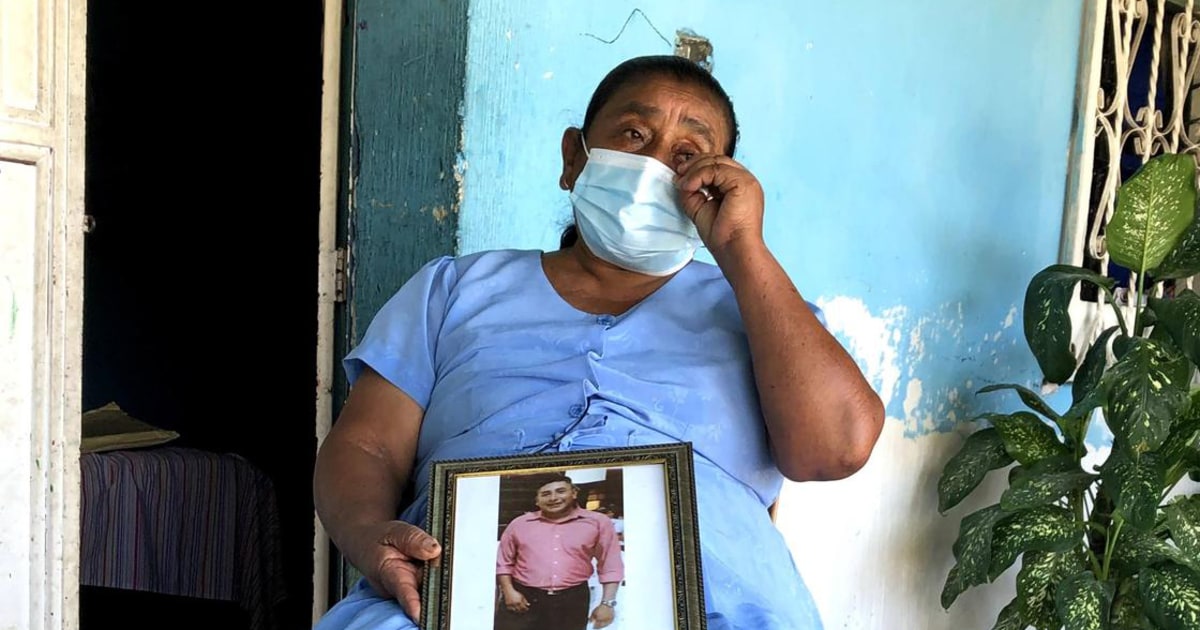
SAN PEDRO PINULA, Guatemala — For seven years, the first thing Carolina Nájera does when she wakes up is go to an altar to the Virgin of Guadalupe in her home, cross herself before the image and light a candle in memory of her husband, Juan Francisco Salguero.
It is a way to have him close, she says, but above all, to give light and tranquility to his soul.
Carolina, 31, imagines that her husband must have lived through hell in the moments leading up to his death.
Salguero left his home in February 2014 and never returned to his town, San Pedro Pinula, a municipality of 61,000 inhabitants in the Jalapa department of southern Guatemala.
Neither did his fellow travelers, which included neighbors and, some of them, relatives: Emiliano Nájera, Gustavo Nájera, José Ronaldo Morales, Maximinio Gómez, Melvin Mateo, Edgar Amilcar Arias Segura, Pedro Gómez and Silvestre Pérez.
The nine Guatemalans were kidnapped and murdered 2,200 kilometers away, in Tamaulipas, Mexico. In a lone mention, a news agency reported in 2018 that a clandestine grave had been found three years later, and their bodies were exhumed and identified.
What the families know is still incomplete. But the fact that they were able to have their loved ones’ remains returned home is a testament to their dogged efforts to seek help and find their loved ones when they went missing.
The massacre had occurred in Güemez, Tamaulipas, according to files of an investigation that the Mexican and Guatemalan authorities never concluded.
Noticias Telemundo Investiga has had access to part of the investigation folder, the forensic reports and the testimonies of the relatives of the migrants to reconstruct the events of this forgotten massacre.
Family prayers and $ 11,600
The nine migrants paid between 50,000 and 90,000 quetzals each ($6,500 and $11,600, respectively) requested by a coyote known to the community, and on Feb. 10, 2014, they started their trip to the United States. They would become part of a larger group of people from the area traveling north. The coyote told them that the journey was safe.
Gustavo Nájera, 35, was part of the nine. “We never imagined what would happen next,” Benjamín, his brother, says.
Two weeks before, Gustavo had come home excited, telling the family that he had the possibility of traveling to the U.S. He’d had the idea to go for years, but between providing for his seven children and paying debts it was nearly impossible to raise the money he would need. But then he found a contractor, or intermediary, to get access to the coyote, the person who negotiates with the families the price and the date of departure.
This intermediary told them that they should leave some house or land as collateral to cover the cost of the trip. The family accepted the deal.
“Before he left for the United States, the coyote came to see the house and said that he would accept it. So, in order to guarantee Gustavo’s crossing, we gave him the deeds so that he could keep the house if we did not pay the full cost of the trip,” Benjamín said.
They left in the early hours of Feb. 10 from the municipality of San Luis Jilotepeque. There they had to meet the coyote, “Marcos,” who would take them to Mexico to deliver them to another coyote. The latter had to take them across the U.S. border.
The day before Gustavo left, they said goodbye for the last time: the family got together, ate together, hugged and prayed that everything would go well.
“It seems that the prayers weren’t enough because we never imagined that it would be the last time we shared food with him and that I could see my brother in the eye,” Benjamín said, flipping through the family photo album.
“We have to start looking for them”
Lorena Morales remembers playing with her brother José Ronaldo, who was three years younger, and pretending to be bus drivers. It was so much fun; while one pretended to be the driver, the other charged the fare. They would spend hours and hours playing. They were very close.
“I don’t think I’ll ever get over his death. I still think one day he is going to come and we are going to sit in the trees where we played when we were children,” she said of her brother who was 21 when she last saw him.
Two days after starting the trip, José Ronaldo called Lorena to deposit 6,000 quetzals ($770) for the coyote. They were about to cross into Mexico and, if he didn’t deposit the money, they would take him back to Guatemala, he told his sister.
Gustavo Nájera called his mother, Marta, seven days after he left Guatemala. He told her that the group was near the border with the United States, in Reynosa, in the state of Tamaulipas, Mexico.
That was the last communication from anyone in the group of migrants before they disappeared.
“Two weeks after the last call, the atmosphere began to feel tense. The families did not hear from them again and the anguish began to invade us,” Morales said.
Carolina Nájera waited the 20 days that her husband told her it would take him to reach the U.S. The coyote had been clear: no one could carry a cellphone, so Juan Francisco left the house with only a change of clothes, another pair of shoes and his identification card.
When 20 days had passed, Carolina dialed the coyote’s number. On the other end of the phone, she heard an annoyed voice: “Why are you calling me? Everything is going well, don’t worry.”
When her husband left, Carolina was two months pregnant and was caring for her then 2-year-old son, who has cerebral palsy. Juan Francisco’s work as a farmer was not enough to pay for the boy’s doctors, so he decided to try his luck looking for a job in the U.S. in order to send money to his family.
Weeks passed and fathers, mothers, wives, children and siblings of some of the nine migrants began to meet every night. “We have to start looking for them,” Gustavo Nájera’s mother, Marta, said. They kept on asking the coyote, Morales even went to his house to ask him. “I tried going with a cellphone to record him but he discovered it and threatened to kill me if I did.”
A jail, a warehouse and a possible kidnapping
The coyote insisted that the group of migrants was fine; he said they were only waiting because the line to cross the border had become difficult.
The relatives held off for a few more days but, in their desperation to hear from their loved ones, they again confronted the coyote and, from here, the trail of the migrants became blurred.
According to the investigation folder, there were clues that needed to be investigated and corroborated.
One was that the trafficker told the families that the group had been detained by police officers and was in a prison known as “La Grande” in San Fernando, Tamaulipas. This data was recorded but was never investigated by the office of the then-attorney general. There is no evidence that there is a prison there known by that nickname.
Weeks later, a young man who had been part of the larger migrant group traveling north called relatives and said they had been locked in a warehouse located five minutes from the Rio Grande. The young man explained that he was able to cross the U.S. border; he had managed to escape from the cellar and go with another coyote. Once on U.S. soil, he contacted some relatives of the nine migrants from San Pedro Pinula who were missing and told them what had happened.
The Office of the Mexican Attorney General points out the possibility that in that warehouse, they were kidnapped by organized crime members, but this information could not be verified by them.
Investigators had one more clue. The relatives said that the coyote they hired in Guatemala told them that on Feb. 18, 2014, he received a call from one of the guides. He told them that the group had taken a bus in Guanajuato, had passed Lagos de Moreno, Jalisco, and had arrived in Tamaulipas. There, a checkpoint of judicial or federal police (this is stated in the investigation folder) waited for them to collect a bribe to be allowed to continue on the road. According to the coyote, the driver told him that at the checkpoint, the police took the migrants off the bus and ordered the driver to leave.
But this account could not be corroborated either. Nobody knows what really happened. The coyote was never detained and did not provide further information. What’s more, he threatened family members to stop asking him.
The relatives went to the Guatemalan prosecutor’s office three months after the migrants’ disappearance, where officials took their statements, assuring them it was up to the Mexican government to begin the investigations.
In Mexico, at the request of the Guatemalan government, the Tamaulipas prosecutor’s office and the attorney general’s office opened an investigation. For more than a year, from 2014 to 2015, no government agency made progress in the investigations.
Morales said it was the worst year of her life, describing it as a “bad dream.” Today, she regrets having paid the coyote who took the group to Tamaulipas. “Why did I pay?” she said as she hugged the wooden frame that holds her brother’s photo. Morales believes that the coyote turned them over to organized crime.
According to a recent report by the Mexican Federation of Public Human Rights Organizations (FMOPDH), at least 2,000 migrants disappeared in Mexican territory in 2020. The U.S. Department of State has put the Mexican state of Tamaulipas at the same “Do Not Travel” level of danger as countries such as Syria and Iraq.
Human remains —and beer cans
On Feb. 16, 2015, an agent of the Tamaulipas Public Ministry reported the discovery of the clandestine grave in Güemez, Tamaulipas.
The Mexican army found it in an area surrounded by fruit trees. It was an excavation over three feet long and about a foot and a half wide.
In the background were bones of human forearms and a pair of hands tied with a belt, as well as empty beer cans and two glass bottles.
The experts began the excavation and found six more human cadavers. In total, 16 bodies were exhumed, and nine of them belonged to the group of Guatemalans who had left San Pedro Pinula on February of 2014.
The experts found in the trouser bag of one of the bodies a credential issued by the Guatemalan government in the name of Santos Cruz Gómez Castro, a resident of El Zunzo, a community close to San Pedro Pinula. This would become the common thread to help identity the rest of the bodies .
After the bodies were exhumed, they remained frozen in the Forensic Medical Service Amphitheater in Ciudad Victoria, Tamaulipas until the nine migrants’ remains were identified in 2018, when the Foundation for Justice and the Democratic State of Law assumed the legal representation of family members.
The Argentine Forensic Anthropology Team also participated in the identification process, the same team that helped in the investigations into the 43 rural college students from Ayotzinapa, Mexico, who went missing in 2014 after they were taken by local authorities in Iguala.
In their report, the Argentine experts determined that the Guatemalan migrants had been tortured before they were killed with a firearm; some were shot in the head. All had the same degree of decomposition and similar injuries. Forensics concluded that they were murdered on the same day and under similar circumstances.
The bodies of three other migrants were also found: Carlos Roberto Mejía Sánchez, Iris Teresa Reyes Rubí and Ramón Edgardo Vásquez Díaz.
A grim return home
The nine migrants who left together on the same day from San Pedro Pinula returned to their town the same day, four years and eight months later Oct. 27, 2018. But they did so in wooden boxes.
The coffins were buried in the local cemetery in the presence of many residents who attended the funeral, shocked by a tragedy they had just learned about. Everyone wondered how, after almost five years, the relatives had managed to find the bodies.
Five migrant massacres and a forgotten massacre
It had been in May of 2014 when one of Gustavo Nájera’s eight siblings asked the Foundation for Justice and the Democratic Rule of Law, (FJDRL) — a nongovernmental organization based in Mexico City — for help in locating the group.
“If we had not intervened, no entity in Mexico would have initiated an investigation of the events,” said Fabianne Cabaret, one of the group’s coordinators.
The migrants’ relatives said their country’s government didn’t help. “They have not supported us,” Carolina Nájera said.
“Guatemala annulled the process of taking DNA samples from us and was refusing to receive the bodies,” Benjamín Nájera said.
Noticias Telemundo contacted the Guatemalan Embassy in Mexico, but received no response to a request for comment.
“The common denominator is impunity”
The finding of the mass grave at Güemez did not have the impact or coverage of other massacres. No one spoke of the grave when the Mexican army found it.
“No one would have remembered them. In those years, 2014-2015, graves were no longer counted,” Benjamín Nájera said. “At the level of truth, justice and reparation, the common denominator is impunity. It is the lack of clarification of how the events occurred and the lack of attention and reparation to the families, even more so for families that do not live in Mexican territory.”
Statements in the Mexican government’s website corroborate the area’s dangers. “If it is considered that 63 percent of the migrants who transited through Mexico and who were returned by the United States authorities declared they entered through the state of Tamaulipas, it is possible to conclude that the migratory route of the Gulf of Mexico is the most used but it is also the most risky, since only in Tamaulipas, four out of every 10 migrants who passed through Veracruz and Tabasco died.”
The Güemez massacre is one in a history of massacres during the last decade.
In August of 2014, the “San Fernando Massacre” resulted in the murder of 72 migrants, 58 men and 14 women, mostly from Central and South America. According to investigators, they were killed after families hadn’t paid to free them and they refused to be recruited by the Zetas, the criminal group blamed for the executions.
The next year, in April 2011, remains of 193 people were discovered in 48 clandestine graves. The bodies of mostly migrants on their way to the U.S. showed signs of arbitrary execution; 130 died as a result of blows with blunt objects —some inflicted by victims forced to do so to other victims — and 80 percent of the remains showed traces of torture.
In May of 2012, the Mexican army reported the discovery of 49 human torsos on a highway in the municipality of Cadereyta, Nuevo León. They were of 43 men and six women, and only 10 victims of Honduran nationality who were fleeing their country for the U.S have been identified.
More recently, in January and also in Tamaulipas, 19 people of Guatemalan and Mexican origin were burned about 43 miles from the U.S. border . Twelve state police officers were arrested for their possible participation in the murders.
None of the cases have been fully resolved, nor have those responsible been brought to justice.
“We can go and leave flowers on their graves, but we ask for truth, justice and that the Mexican authorities also investigate,” Carolina Nájera said.
FJDRL’s Cabaret says that in the case of the Güemez massacre, justice requires first knowing what happened and why the migrants were killed, something that’s almost impossible. “It is more likely that another massacre will occur,” Cabaret said, “before we know the truth about the previous ones.”
An earlier version of this story was first published in Noticias Telemundo.
Follow NBC Latino on Facebook, Twitter and Instagram.
Source: | This article originally belongs to Nbcnews.com










